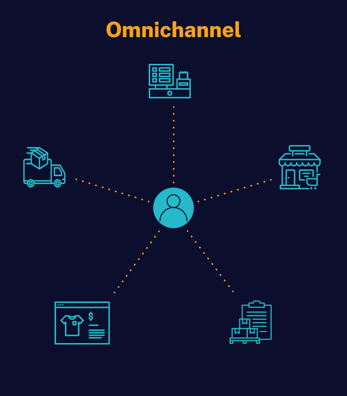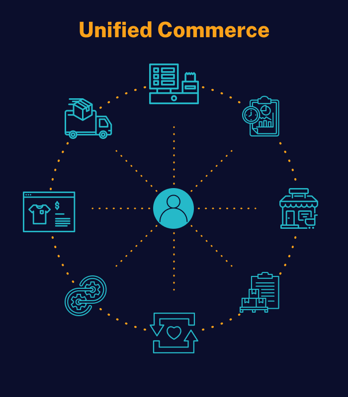Why Unified Commerce is a Game Changer for Retailers

Today’s ultra-competitive environment presents a unique opportunity for nimble mid-market retailers to outperform the competition. Consumers are rewarding merchants that offer seamless, unified shopping experiences. And retailers are discovering how unified commerce translates not only to satisfied customers and increased sales but also to operational efficiencies.
In this post, we explore the differences (and similarities) between omnichannel and unified commerce. We also outline the top 3 benefits of unified technology and how a unified approach can level up your retail game.
IN THIS ARTICLE
- The Difference Between Omnichannel Retail & Unified Commerce
- How to Achieve Omnichannel Excellence through Unified Commerce
- The Top 3 Benefits of Unified Commerce for Retail Chains
- Why You Should Level Up Your Retail Game with Unified Commerce
What’s the Difference: Omnichannel Retail vs. Unified Commerce
Omnichannel retail and unified commerce have similarities and the terms are often used interchangeably. However, there are crucial differences. Both offer a significant improvement over multichannel, but the benefits of unified commerce outweigh those of a purely omnichannel approach.
To help you understand which approach is best for your retail operation, here’s a quick definition of each:
Most notably, the customer sits at the center of a unified commerce experience.


The UK Ecommerce Association further describes omnichannel retail as an integrated approach that links channels such as retail stores, websites, marketplaces, social, and more. Unlike multichannel retail, it allows for communication and customer experiences between channels. But omnichannel simply is not enough in today’s retail environment. While omnichannel might provide a good customer experience across channels, it’s often a mess in the back end for the retailer.
In contrast, unified commerce creates a seamless and consistent customer experience across all channels through connected back-end systems. By harmonizing all channels, payment systems, products, and customer data, retailers can deliver a fully integrated, measurable, and frictionless experience.
In other words, omnichannel retail attempts to link silos, disconnected systems, and channels. Unified commerce does this and more by combining all back-end systems with all customer-facing channels. This allows crucial data to travel across systems in real time while maintaining updated and accurate information.
As a result, unified commerce enables consumers to easily shop, buy, receive, and return items while weaving in and out of their chosen channels. With unified commerce, you get omnichannel retail and much more.
Raising the Bar: Achieving Omnichannel Excellence through Unified Commerce
Most retailers are currently integrating their way toward omnichannel. However, growth-oriented retailers are taking it a step further with unified commerce. A move from disparate retail software systems to a unified platform enables the next level of omnichannel retail – omnichannel excellence.
Achieving omnichannel excellence means delivering exceptional, seamless, and fully connected customer experiences while outmaneuvering the competition to become the industry leader that your competitors are chasing.
Regional and mid-market retailers stand to gain a significant competitive advantage by seizing the opportunities presented by unified commerce. Unified commerce fulfills the promise of harmonious shopping experiences, enabled through truly connected systems and a single real-time data source. Meaning you no longer have to settle for an omnichannel experience that complicates the back end of your operation – you can achieve a seamlessly connected operation with omnichannel excellence instead.
Unified retail management software like the FieldStack platform drives all transactions from one database updated in real time. It leverages data collection points that span operations and capture every customer interaction. Products, stock, order status, and other data are constantly shared across channels, allowing for an exceptionally efficient and relevant shopping journey with data, analytics, and automation at the core.
Consumers have been demanding multichannel and omnichannel experiences for years. Now they want more. They want omnichannel excellence – and a unified experience. Retailers need an easier way to deliver these enhanced experiences for customers and employees.
With the help of a unified commerce platform, retailers can deliver on the promises of omnichannel and unified commerce. FieldStack positions retailers with the capabilities they need today and the assurance of staying ahead of what their customers will want tomorrow.
What Holds Retailers Back from Meeting Omnichannel Expectations?
As mentioned above, shoppers are craving a unified experience. They expect a seamless path, including an accurate view of product information, stock positions, and purchase history across channels.
While most retailers appear to have achieved omnichannel success, they still struggle to deliver on these expectations consistently and efficiently. With disconnected systems, essential services like inventory, in-store pickup, and ship-from-store become a major challenge.
The stakes are higher than ever. Businesses are experiencing lost sales, customer attrition, and profit erosion – all while claiming to have reached omnichannel success.
But why are retailers focusing on omnichannel without leveraging unified technology?
Well, legacy technology is difficult to work with and the constant upgrades and integrations are expensive. Replacing this investment with a modern, unified platform can seem overwhelming. In fact, according to the 33rd Annual Retail Technology Study, one of the biggest retail challenges in 2023 involves moving away from legacy systems. Legacy tech stacks are inefficient, disconnected, and difficult to maintain. More retailers are seeing the need to retire these old systems and point solutions that hold them back.
This challenge is emphasized by EY as they explore how organizations use retail software to meet consumers’ growing demands:
“Putting new and emerging technologies as bolt-ons to legacy infrastructure will only slow things down and make experiences worse. Too many retailers struggle with integrating new technologies with old systems.”
Retailers have been left with the burden of cobbling systems together as they trudge the road toward omnichannel and unified commerce. Fortunately, retail software has evolved, and there is now an alternative. With FieldStack, our platform eliminates ongoing integrations – essentially becoming the last core systems upgrade a retailer will ever need.
Plus, making the switch to a unified approach comes with even more benefits to the retailer. With unified commerce, retailers can have their cake and eat it too – by adding customer value and increasing operational efficiency. This concept of having both was unattainable until unified commerce platforms came along. Retailers no longer need to be restrained by traditional tech stacks.
The Top 3 Benefits of Unified Commerce
Retailers can experience the advantages of unified commerce by leveraging real-time customer and operational data within a truly unified retail management system. The real-time data drives predictive modeling, machine learning, automated inventory, and advanced analytics.
Additionally, our unified commerce platform takes the complexity out of technology so retailers can achieve omnichannel excellence, create great customer experiences, and profitably grow their businesses. The benefits below will show you how.
1. Increase sales by exceeding customer expectations
Unified commerce makes life easier for the consumer and brings simplicity to the retailer. And sales increase with highly personalized, relevant, and frictionless customer experiences.
Why? Because today’s customers want to shop, purchase, and return goods seamlessly across sales channels. They expect omnichannel excellence. Conveniences like self-checkout, in-aisle checkout, and enhanced loyalty programs drive sales further. Unified commerce solutions like FieldStack's unified commerce platform make it easy to deliver such capabilities.
Beyond convenience, unified commerce uses insights and automation to ensure that shelves are stocked with the items that consumers want. An effective platform helps you stock the correct items at the right time, location, and price. At the same time, you’ll benefit from optimized inventories based on seasonality, regional preferences, single-store tendencies, and other predictive information.
2. Reduce costs by simplifying operations
Unified commerce brings efficiency to retail operations. FieldStack’s unified commerce platform applies Lean Retail principles to manage the efficiency and flow of resources – enabling mid-market retailers to optimize operations and effectively compete against online and global retailers. Specifically, FieldStack clients win on product availability, convenience, and the overall value they provide.
By unifying all channels, payment systems, products, and customer data, retailers can deliver a fully integrated, measurable, and frictionless experience.
Our clients meet their customers’ expectations while efficiently managing orders, thanks to real-time visibility, automated inventory management, and more. In addition, they are freeing up capital by improving inventory turns, reducing out-of-stocks, and eliminating slow sellers.
3. Grow sustainably by streamlining technology
Retail organizations today are facing an urgent need to revamp their operations and rethink their tech stacks to keep pace with the competition. Many are spending considerable resources on legacy systems and software — including manual workarounds, integrations, and ongoing maintenance.
But legacy technologies and cobbled tech stacks struggle to meet evolving retail needs. With resources tied up in inefficient traditional tech, retailers cannot focus on areas that support growth. Leveraging unified technology instead connects the core retail systems needed to run a thriving chain and achieve omnichannel excellence. This frees up capital and resources, allowing retailers to profitably grow their chains.
Level Up Your Retail Game with a Unified Commerce Solution
Today, the benefits of a unified commerce platform are within reach for almost any retailer. From pet specialty to hardware, from books to electronics, regional and mid-market retailers are replacing their cobbled legacy software stacks and implementing cloud-based unified commerce platforms. With immediate returns and continuous enhancements included, this approach positions retailers with the adaptability needed for long-term success.
FieldStack’s retail management software is the unified commerce platform that was built for growth-minded retailers. It combines the core systems needed to run a thriving retail chain – robust point of sale (POS), eCommerce, inventory, supply, loyalty, real-time actionable data, and more.
Learn more with our free Lean Retail Web Class to discover the benefits of unified commerce for your retail chain.